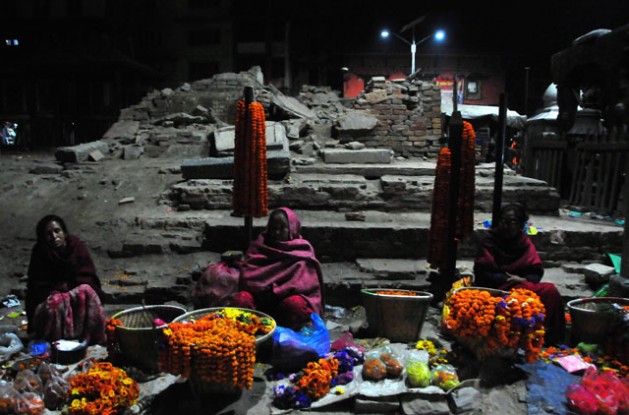Quake Fear Stalks Kathmandu

KATHMANDU(IPS): Early evening, there is a play of light and shadow over Kathmandu’s famous Durbar Square. The rising monuments, damaged by the April 2015 earthquake, appear as dark silhouettes while large flash lights streak through in between them.
Young men and women sit on the monuments damaged by the earthquake. Some even hang on to temporary scaffoldings in place to strengthen the buildings, some of which are over 500 years-old.
Santhos Sharma, a 30 year-old man who sells trinkets to visiting tourists at the square, smiles at them and shrugs his shoulders.
“What else can they do, they can’t live in fear all the time.”
But Sharma like many others who survived, fears the next big one. Despite the devastation of the 2015 April earthquake – it left over 9,000 dead, over 27,000 injured and a recovery bill of over USD$3 billion – many here know that the 7.5 magnitude quake could have been worse.
A yellow fading notice pasted on the narrow stairwell of the Nepali Red Cross headquarters about two years before the earthquake warned that Kathmandu Valley is most vulnerable. Around 40,000 people may die, 95,000 persons may be seriously injured and 60 per cent of houses will be totally destroyed according to a study.
“Nobody here knows what to do, or how to react if there is another quake,” said Sharda Bista, a Kathmandu resident said. “People also have very few options to be safe.”
Bista pointed to a row of narrow dimly-lit rooms, diagonally supported by columns of wooden poles. “Those buildings can collapse at the slightest jolt, but where can they move.”
All of them are also living on top of constant danger.
A recent international study found that the sub-surface Himalayas were constantly shifting and one of the most volatile regions in the world. The study published in Nature Geoscience in January also warned that there was dangerous potential for another major quake in the region.
The below surface rupture during the 2015 April quake stopped 11km below the surface, but constantly building pressure beneath the Indian sub-continent could force the rupture to snap again.
“Work on other earthquakes has suggested that when a rupture stops like this, it can be years or decades before it resumes, rather than the centuries that might usually be expected,” lead author Dr John Elliott of Oxford University said.
“Unfortunately, there is no way of predicting precisely when another earthquake will take place. It’s simply a case of countries and cities making sure they are well prepared for when it does happen.”
Ordinary people like Sharma and Bista worry that with very real little preparation or awareness, the jam-packed Kathmandu Valley – population of 2.5 million, or close to 10 per cent of the national population and one of the fasted growing metropolises in South Asia according to the World Bank, is a death trap. Over 13,000 persons are packed into a square kilometer here.
There are constant reminders of danger. On the afternoon of February 24, there was yet another jolt recorded at a magnitude of 4.7 on the Richter scale. There have been many such jolts since the April earthquake. Soon after such minor tremors, social media is replete with jokes on how Kathmandu is now used to them.
“But we are not,” Sharma says. He told IPS that he does not when or how he would get warnings on post-earthquake situations. The best format is the mobile, but as the last earthquake showed the networks can get clogged.
Bista said that the most potent public information medium in the immediate aftermath of the earthquake was the radio. “People were crowding around them for information,” she said.
However, there is yet to be a public awareness campaign on evacuations or safe routes to take after an earthquake or even on different threat levels and warnings. The Nepal Academy of Science and Technology has installed an earthquake detection mechanism that can detect jolts within seconds, but the main problem remains in how to disseminate such information among vulnerable millions.
Simply put, ordinary Nepalese remain confused on how to react to an earthquake.
Amidst these dangers, latest reports filed by relief agencies indicate that a year into the disaster, many of the victims are yet to received pledged assistance.
“In January, 61 per cent of respondents stated that their main needs have not been addressed, while 28 per cent believe their main problems have been addressed,” the latest Inter-Agency Common Feedback Report, that tracks perceptions among beneficiaries said.
The report noted that while the percentage of those complaining that aid has by-passed them had fallen in December and January, still close to three-quarters of respondents identified long-term shelter, health care, financial support and safe water as main needs yet to be met.
The slowdown in aid delivery was partly due to political wrangling that prevented the National Reconstruction Authority (NRA) from accessing and distributing funds till January this year. When a government changeover took place in October, Govinda Raj Pokhrel, who was appointed as NRA head in August lost his job as he was seen as being close to the former government of the Nepal Congress Party.
Pokhrel had initiated a survey of the damages, but with his removal progress slowed down. “After I left, the work really slowed down,” Pokhrel said recently. Even UN agencies are still searching for updated statistics from government departments. There is a new NRA head and the hope among relief agencies is that finally seven months after the earthquake, the reconstruction effort can take off earnestly.
But there is very little confidence among ordinary Nepalis that they can face the next big one better prepared than the last one.
“I don’t think we are, there are no contingency plans, no public awareness, no initiative to be safe, we just walk on the same fault lines hoping nothing will happen,” Bista said.
(INTER PRESS SERVICE)



